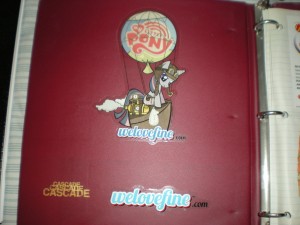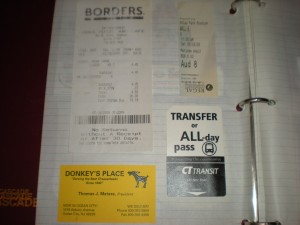Quite sometime ago, I talked to you about how to get ideas for your comics. That article is a good start (go back and read it if you haven’t already) – but some of you may need more of a jumpstart when it comes to getting inspiration for comics. Well, look no further. I’ll reveal a few strategies to help you out. I have a couple of sources I use in getting inspiration for comics.
This first tactic of mine is not my own idea. It was actually given to me by British fantasy illustrator Finlay Cowan from his text, Drawing and Painting Fantasy Figures (Barron’s Educational Series, 2003). You can put together an inspirational scrapbook. Ready made scrapbooks can be purchased at arts and crafts stores or you can make one with a binder and notebook paper, like I did.
Collect clippings from newspapers and/or magazines. Gather packaging and wrappers. Cut out any weird or funny illustrations. Attach these to your scrapbook pages with tape or glue. What do you do then? You can flip through these pages to spark an interesting idea for your next comic or your next airbrush illustration or your next oil painting, etc. Each of these found items in your scrapbook tells a story. What is it? Where was it made? These can get you thinking and helps you enter a state of mind where you can truly bring plots and characters in your comics to life.
Before we continue on, some of you may scoff at having an inspirational scrapbook. You might think “Why does this Max West weirdo keep an old-fashioned scrapbook? He should get with times and use a computer.” As a matter of fact, I have a second inspirational scrapbook – it’s in the form of a portable hard drive and CD! I collect tons of images from around the Internet and store them in my digital inspirational scrapbook too. Among images I gather are video game/computer game boxes, screenshots from movies, cartoons, and anime, album covers, vintage print ads, comic book covers, old photographs, and much more. These pretty much serve the same purpose as my traditional paper scrapbook. Before I start writing a script for Sunnyville or before I start my pencil work, I’ll take a look through my digital scrapbook to jog my energy.
Another source of inspiration can be art magazines. There are many out there from art history and criticism to fine art to illustration. Two examples are ImagineFX and Watercolor Artist. Not only are these handy for staying current and for learning new techniques, but you can also look through the work of others. These can be inspiring as the artwork depicted therein can motivate you to become better and to try something a little different.
Art books are another source in getting inspiration for comics. I have quite a number of art instruction books. Besides learning, the artwork, the techniques, and the author’s unique point of view can really ignite your creativity. Art history books are another good source. I own a number of books by the publishing house, Taschen, profiling all sorts of famous artists from Vincent Van Gogh to Max Ernst to Andy Warhol to Claude Monet. In fact, my favorite artist was the German Expressionist painter Paul Klee (1879-1940) and to help get ideas, I’ll thumb through my books on Klee’s work.
Another source of inspiration can be “Making of” movie books. These books usually go behind the scenes of a movie to explain how it came to be, the origin of the script, production stills, concept art, costume design and so on. One example (which is in my collection) is Hellboy II: The Art of the Movie (Dark Horse, 2008). There are many books out there like this covering Star Wars, Lord of the Rings, the Pixar films, and so on. Besides giving insight into the creative process of film and animation, this can be a handy guide for anyone wanting to go into that field and its inner workings. A word of warning though: these books can be expensive and even used copies can fetch a lot of money on the market.
Last, I have a number of personal inspirational sources. As some of you may know, I am very passionate about the 1980s – the decade of my childhood. In fact, my work Sunnyville Stories is intended to be quite retro. The adults are psychologically and culturally stuck in the Jazz Age while the children/teenagers are psychologically and culturally stuck in the 1980s. I use the book All American Ads of the 80s (Taschen, 2005) for inspiration for both my comics and graphic design. This book series (which covers decades all the way from 1900s to the 1980s) is out of print at present and can cost a fair amount of money. I bought my copy at Strand Books in Manhattan for nearly fifty dollars.
In conclusion, those are some methods of getting inspiration for comics. What are your thoughts on the subject? Where do you get your inspiration from? Feel free to comment here. Don’t forget to subscribe to the RSS feed or through email if you haven’t already.



I have been using the scrapbook tool for years. I’m constantly pulling articles from magazines and newspapers. I love Sports Illustrated for their unique pictures and amazing body positioning. Even if you aren’t into sports, as an artist that focuses on the human anatomy I highly recommend a subscription (a weekly magazine for less than a buck an issue? Sign me up!)
Just taking in the world around you, thinking about what you are experiencing…. These are the things that really get me inspired on a daily basis!
Great article!
Thanks for commenting. Using sports magazines as reference does sound like it might come in handy – I’ll have to remember that.
I am into scrapbooking, too! What I like to do is cut out different fonts and sizes of letter, form it into words and paste it up with my pictures. I’m goint to try out what you did here, too. Thanks for sharing!
Thank you very much for commenting. I’m not much of a scrapbooker per se – I just use paper ones and digital versions for inspiration. Regardless though, you are very right in that it can be quite handy.
Pingback: Finding Inspiration From Charlie Brown's Super Books | Sunnyville Stories